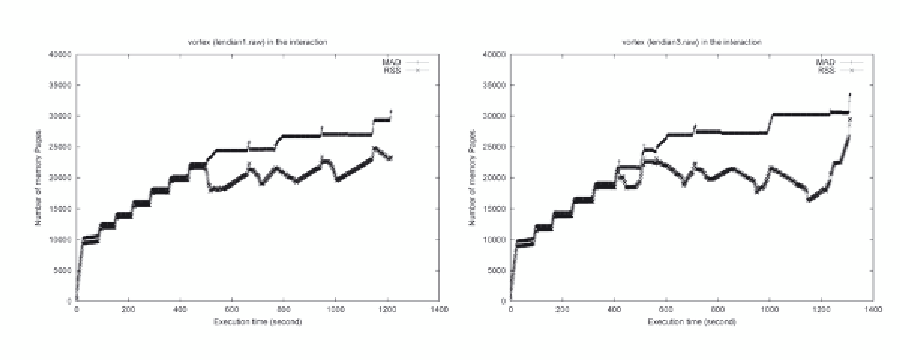Information Technology Reference
In-Depth Information
programs
gcc
and
vortex
. Regarding program
vortex
, its RSS curve suddenly dropped to about
14,000 pages after it reached to 26,800 pages due
to its memory competition from
gcc
. After that,
its RSS curve entered the fluctuating stage. The
fluctuating RSS curves of
vortex
and the first spike
of
gcc
caused a large number of page faults to
both processes, which extended the first spike of
gcc
by 865 seconds, and extended a RSS stair in
vortex
by 563 seconds. The second spike of
gcc
arrived after
vortex
finished its execution. Then it
ran smoothly. The experiments consistently show
that the execution times of both processes are sig-
nificantly increased due to their page faults. The
slowdown of
gcc
is 5.61, and is 3.37 for vortex.
Figure 6 presents the memory behavior mea-
sured by MAD and RSS of
votex1
and
vortex2
,
two concurrently running
vortex
programs, each
with a different input. Although the input files are
different, their memory access patterns are similar.
But neither could establish its working set. The
experiments again show that the execution times
of both programs are significantly increased due
to the page faults in the interaction. The slowdown
for
vortex1
is 3.58, and is 3.33 for
vortex2
.
Figure 7 presents the memory behavior mea-
sured by MAD and RSS of two concurrently
running programs
LU
. The experiments show
that frequently climbing and dropping slopes of
RSS can incur memory reallocations and trigger
fluctuating RSS curves, leading to inefficient
memory use and low CPU utilization. The dy-
namic memory demands from the program caused
the system to stay in the thrashing state for most
of their execution time. The execution times of
both processes are significantly increased due to
the page faults. The slowdowns for the two
LU
processes are 3.57 and 3.40, respectively.
development of thrashing
The experiments have shown that thrashings can
be triggered with a moderate amount of memory
shortage and can cause significant performance
degradations. False LRU pages play their role
in the process -- they make global replacement
policies blind to a program's true memory needs,
and a portion of the working set identified as the
false LRU pages mistakenly replaced. Here are
certain conditions that probably cause thrashings
based on the experimental studies.
Figure 6. The memory performance of two vortex programs (vortex1 and vortex2), each with a different
input, in their concurrent execution.

Search WWH ::

Custom Search